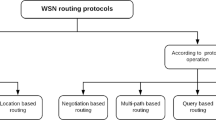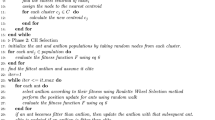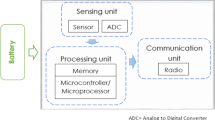Abstract
This paper introduces a collision avoidance slot allocation scheme for Time Division Multiple Access (TDMA) based Medium Access Control (MAC) in multi-cluster wireless sensor networks. TDMA MAC protocols have built-in active-sleep duty cycle that can be leveraged for limiting idle listening. Also, they can overcome the overhearing problem, thus have better energy efficiency. Enabling concurrent intra-cluster communications using a single radio channel is a key issue in TDMA MAC protocols. Using orthogonal frequency channels or different Code Division Multiple Access codes for different adjacent clusters can solve the problem at the expense of cost. In this paper, we propose a new distributed slot allocation protocol called Coordinated Time Slot Allocation (CTSA) that can reduce collisions significantly using a single radio channel. We use simulations to study the effects of different system parameters on the performance of our proposed protocol. Simulation results show that applying CTSA over clustering protocols can significantly reduce collisions. It also shows fast convergence for our proposed CTSA protocol. In this paper we apply our CTSA scheme to the Low Energy Adaptive Clustering Hierarchy protocol which forms the basis for many cluster based routing protocols. CTSA is also compared with the SRSA algorithm proposed by Wu and Biswas (Wirel Netw 13(5):691–703, 2007) by means of simulation.










Similar content being viewed by others
References
Abbasi, A. A., & Younis, M. (2007). A survey on clustering algorithms for wireless sensor networks. Computer Communications, 30, 2826–2841.
Ahmed, N., Dong, Y., Bokareva, T., Kanhere, S., Jha, S., Bessell, T., et al. (2007). Detection and tracking using wireless sensor networks. In Proceedings of the ACM SenSys conference (pp. 425–426).
Anastasi, G., Borgia, E., Conti, M., & Gregori, E. (2004). Wi-Fi in ad hoc mode: A measurement study. In Proceedings of IEEE conference on pervasive computing and communications (pp. 145–154).
Bertinato,M., Ortolan, G., Maran, F., Marcon, R., Marcassa, A., Zanella, F., et al. (2008). RF localization and tracking of mobile nodes in wireless sensors networks: Architectures, algorithms and experiments. Technical report, Department of Information Engineering, University of Padova.
Bhattacharyya, D., Kim, T.-h., & Pal, S. (2010). A comparative study of wireless sensor networks and their routing protocols. Sensors, 10(12), 10506–10523.
Du, X., & Lin, F. (2005). Improving routing in sensor networks with heterogeneous sensor nodes. In Proceedings of the IEEE vehicular technology conference (Vol. 4, pP. 2528–2532).
El-Hoiydi, A. (2002). Aloha with preamble sampling for sporadic traffic in ad hoc wireless sensor networks. In Proceedings of IEEE ICC conference (Vol. 5, pp. 3418–3423).
Elrahim, A. G. A., Elsayed, H. A., Ramly, S. E., & Ibrahim, M. M. (2010). An energy aware WSN geographic routing protocol. Universal Journal of Computer Science and Engineering Technology, 1(2), 105–111.
Guo, C., Hekmat, R., & Pawelczak, P. (2007) Analysis and optimization of energy efficient cluster forming for wireless sensor networks. In Proceedings of IEEE vehicular technology conference (pp. 127–132).
Heinzelman, W., Chandrakasan, A., & Balakrishnan, H. (2000) Energy-efficient communication protocol for wireless microsensor networks. In Proceedings of the international conference on system sciences (Vol. 2).
Jeong, Y., Kim, J., & Han, S.-J. (2011). Interference mitigation in wireless sensor networks using dual heterogeneous radios. Wireless Networks, 17(7), 1699–1713.
Koubaa, A., Severino, R., Alves, M., & Tovar, E. (2009). Improving quality-of-service in wireless sensor networks by mitigating “hidden-node collisions”. IEEE Transactions on Industrial Informatics, 5(3), 299–313.
Kumar, V., Jain, S., & Tiwari, S. (2011). Energy efficient clustering algorithms in wireless sensor networks: A survey. International Journal of Computer Science Issues, 8(2), 259–268.
Oliver, M., & Escudero, A. (1999). Study of different CSMA/CA IEEE 802.11-based implementations. In EUNICE contribution.
Rhee, I., Warrier, A., Aia, M., Min, J., & Sichitiu, M. (2008). Z-MAC: A hybrid MAC for wireless sensor networks. IEEE/ACM Transactions on Networking, 16(3), 511–524.
Sabri, N., Aljunid, S. A., Ahmad, R. B., Malek, M. F., Yahya, A., Kamaruddin, R., et al. (2012). Performance evaluation of wireless sensor network channel in agricultural application. American Journal of Applied Sciences, 9, 141–151.
Song, L., & Hatzinakos, D. (2007). A cross-layer architecture of wireless sensor networks for target tracking. IEEE/ACM Transactions on Networking, 15(1), 145–158.
Wang, Y.-C., Peng, W.-C., & Tseng, Y.-C. (2010). Energy-balanced dispatch of mobile sensors in a hybrid wireless sensor network. IEEE Transactions on Parallel and Distributed Systems, 21,1836–1850.
Wu, T., & Biswas, S. (2007). Minimizing inter-cluster interference by self-reorganizing MAC allocation in sensor networks. Wireless Networks, 13(5), 691–703.
Yadav, R., Varma, S., & Malaviya, N. (2009). A survey of MAC protocols for wireless sensor networks. UbiCC Journal, 4(3), 827–833.
Ye, W., Heidemann, J., & Estrin, D. (2002). An energy-efficient MAC protocol for wireless sensor networks. In Proceedings of IEEE INFOCOM conference (Vol. 3, pp. 1567–1576).
Younis, O., Krunz, M., & Ramasubramanian, S. (2006). Node clustering in wireless sensor networks: Recent developments and deployment challenges. IEEE Network, 20(3), 20–25.
Author information
Authors and Affiliations
Corresponding author
Rights and permissions
About this article
Cite this article
Al-Shawaqfeh, M., Abu-El-Haija, A. & Abdel Rahman, M.J. Collision avoidance slot allocation scheme for multi-cluster wireless sensor networks. Wireless Netw 19, 1187–1201 (2013). https://doi.org/10.1007/s11276-012-0527-z
Published:
Issue Date:
DOI: https://doi.org/10.1007/s11276-012-0527-z




